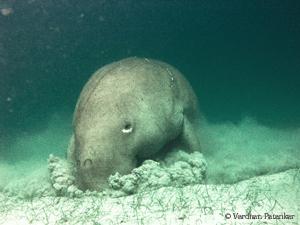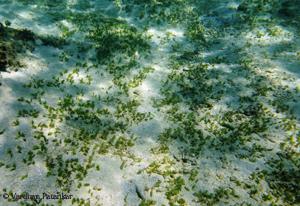Roshni Yathiraj
The primary aim of this project is to study the processes by which epiphytic algae and sedimentation in seagrass meadows affect dugong herbivory. The broader aim is to understand the processes that drive algal growth and sedimentation in meadows.

Dugong Feeding at Neil Island. © Vardhan Patankar.
Dugongs are currently listed as ‘Vulnerable to extinction’ in the IUCN Redlist, and in India, are awarded the highest level of legal protection. Recent research indicates that in the Andaman and Nicobar archipelago, as a consequence of low population numbers, dugongs show high fidelity towards select seagrass meadows. Although seagrasses have the ability to cope with persistent grazing, dugongs modify these meadows to maintain preferred early successional species of seagrasses. Therefore, even the slightest fluctuations in meadow dynamics could change the grazing behaviour of these dugongs.

Dugong Feeding Trails at Neil Island, Andaman Islands. © Vardhan Patankar
Multiple factors affect the growth rate of seagrasses, which could in turn impact dugong herbivory. These factors include sedimentation, epiphytic algal growth, nutrient content of the water, depth and light, amongst others. Knowledge from previous research and of local conditions in the Andaman and Nicobar islands, leads us to hypothesize that sedimentation and epiphytic algal growth on seagrasses are the most important factors that affect dugong herbivory. With this project, we propose to carry out a detailed study on the effect of these two factors on dugong herbivory in seagrass meadows. Our broader aim will be to understand the underlying processes that drive algal growth and sedimentation in these meadows. Although similar studies have been conducted in other geographical regions, this study will allow us to interpret local influences in the area that affect small and isolated populations of dugongs.
We propose to conduct the field experiments of this study across a year to accommodate for seasonal variations. Meadows that are easily accessible throughout the year and that are known for consistent use by dugongs have been chosen as study sites. At these sites, permanent markers will be set up to ascertain the rates of algal growth and sedimentation.
On-going conservation efforts for dugongs are currently under way in the form a species recover program, managed by the Forest Department of the Andaman and Nicobar Islands. The department is in the process of formulating strategies to manage sites that have been identified as suitable for dugong habitation. A report of the findings of this study will be submitted to the department to aid their efforts, as information of the factors that affect dugong herbivory could strengthen their approaches.